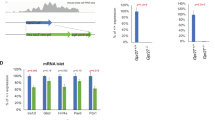Abstract
THE receptor for insulin-like growth factor type 2, also known as the cation-independent mannose-6-phosphate receptor (Igf2/Mpr), is a multifunctional receptor thought to play a role in lysosomal targeting, cell growth and signal transduction1–8. Igf2/Mpr has been mapped to the mouse Tme9 locus and shown to be an imprinted gene10, which further suggests a role in embryonic growth regulation. To define the functions of Igf2/Mpr, we have generated mice lacking this gene. We report here that maternal inheritance of an Igf2/Mpr null allele (−/+) as well as homo-zygosity for the inactive allele (−/−) is generally lethal at birth and mutants are about 30% larger, indicating that maternal expression of Igf2/Mpr is essential for late embryonic development and growth regulation. The phenotype is probably caused by an excess of Igf 2 because the introduction of anIgf2 null allele rescued the Igf2/Mpr mutant mice. Mutant mice also have organ and skeletal abnormalities and missort mannose-6-phosphate-tagged proteins. A few (−/+) mice reactivated their paternal Igf2/Mpr allele in some tissues and survived to adults. But no (−/−) mice survived, indicating a role for the reactivated paternal allele in postnatal survival.
This is a preview of subscription content, access via your institution
Access options
Subscribe to this journal
Receive 51 print issues and online access
$199.00 per year
only $3.90 per issue
Buy this article
- Purchase on Springer Link
- Instant access to full article PDF
Prices may be subject to local taxes which are calculated during checkout
Similar content being viewed by others
References
von Figura, K. Curr. Opin. Cell Biol. 3, 642–646 (1992).
Kornfeld, S. A. Rev. Biochem. 61, 307–330 (1992).
Kyle, J. W., Nolan, C. M., Oshima, A. & Sly, W. S. J. biol. Chem. 263, 16230–16235 (1988).
Oka, Y., Rozek, L. M. & Czech, M. P. J. biol. Chem. 260, 9435–9442 (1985).
Dennis, P. A. & Rifkin, D. B. Proc. natn. Acad. Sci. U.S.A. 88, 580–584 (1991).
Lee, S.-J. & Nathans, D. J. biol. Chem. 263, 3521–3527 (1988).
Herzog, V., Neumüller, W. & Holzman, B. EMBO J. 6, 555–560 (1987).
Murayama, Y. et al. J. biol. Chem. 265, 17456–17462 (1990).
Johnson, D. R. Genetics 76, 795–805 (1974).
Barlow, D. P., Stöger, R., Herrmann, B. G., Saito, K. & Schweifer, N. Nature 349, 84–87 (1991).
Mortensen, R. M., Conner, D. A., Chao, S., Geisterfer-Lawrence, A. A. T. & Seidman, J. G. Molec. cell. Biol. 12, 2391–2395 (1992).
Stöger, R. et al. Cell 73, 61–71 (1993).
Latham, K. E., Doherty, A. S., Scott, C. D. & Schultz, R. M. Genes Dev. 8, 290–299 (1994).
Kaufman, M. H. in The Atlas of Mouse Development (ed. Kaufman, M. H.) (Academic, London, 1992).
Ramirez-Solis, R., Zheng, H., Whiting, J., Krumlauf, R. & Bradley, A. Cell 73, 279–294 (1993).
Vogler, C. et al. Am. J. Path. 136, 2207–217 (1990).
Nolan, C. M. & Sly, W. S. in Metabolic Basis of Inherited Disease (eds Scriver, C. R., Beaudet, A. L., Sly, W. S. & Valle, D.) 1589–1601 (McGraw-Hill, New York, 1989).
Forejt, J. & Gregorova, S. Cell 70, 443–450 (1992).
Filson, A., Louvi, A., Efstradiadis, A. & Robertson, E. J. Development 118, 731–736 (1993).
DeChiara, T. M., Efstradiadis, A. & Robertson, E. J. Nature 345, 78–80 (1990).
Köster, A. et al. EMBO J. 12, 5219–5223 (1993).
Ludwig, T. et al. EMBO J. 12, 5225–5235 (1993).
DeChiara, T. M., Robertson, E. J. & Efstradiadis, A. Cell 64, 849–859 (1990).
Feinberg, A. P. Nature Genet. 4, 110–113 (1993).
Christofori, G., Naik, P. & Hanahan, D. Nature 369, 414–418 (1994).
Le Mouellie, H., Lallemand, Y. & Brulet, P. Proc. natn. Acad. Sci. U.S.A. 87, 4712–4716 (1990).
Wang, Z-Q. et al. Nature 360, 741–745 (1992).
McLeod, M. J. S. Teratology 22, 299–301 (1980).
Moullier, P., Marechal, V., Danos, O. & Heard, J. M. Transplantation 56, 427–432 (1993).
Frankel, H. A., Glaser, J. H. & Sly, W. S. Pediat. Res. 11, 811–816 (1977).
Author information
Authors and Affiliations
Rights and permissions
About this article
Cite this article
Wang, ZQ., Fung, M., Barlow, D. et al. Regulation of embryonic growth and lysosomal targeting by the imprintedIgf2/Mpr gene. Nature 372, 464–467 (1994). https://doi.org/10.1038/372464a0
Received:
Accepted:
Issue Date:
DOI: https://doi.org/10.1038/372464a0
This article is cited by
-
Allosteric regulation of lysosomal enzyme recognition by the cation-independent mannose 6-phosphate receptor
Communications Biology (2020)
-
Maternal transmission of an Igf2r domain 11: IGF2 binding mutant allele (Igf2rI1565A) results in partial lethality, overgrowth and intestinal adenoma progression
Scientific Reports (2019)
-
Genomic imprinting and its effects on postnatal growth and adult metabolism
Cellular and Molecular Life Sciences (2019)
-
mTORC1 regulates mannose-6-phosphate receptor transport and T-cell vulnerability to regulatory T cells by controlling kinesin KIF13A
Cell Discovery (2017)
-
The formation of multivesicular bodies in activated blastocysts is influenced by autophagy and FGF signaling in mice
Scientific Reports (2017)
Comments
By submitting a comment you agree to abide by our Terms and Community Guidelines. If you find something abusive or that does not comply with our terms or guidelines please flag it as inappropriate.



